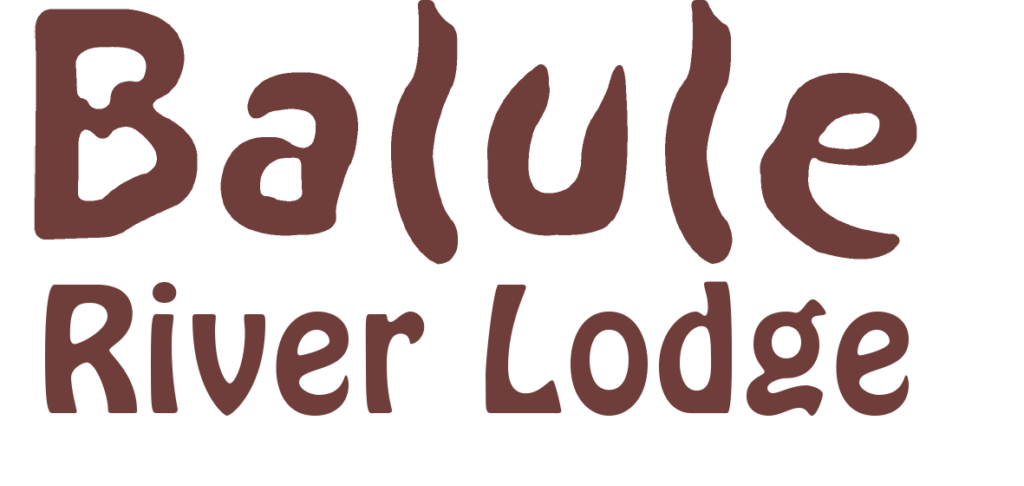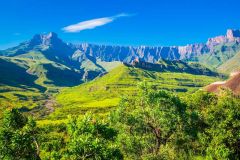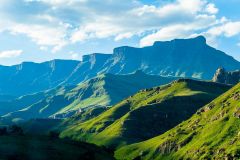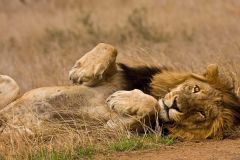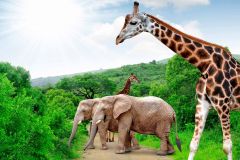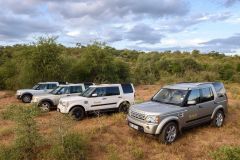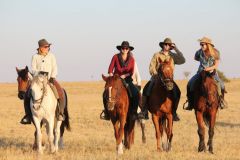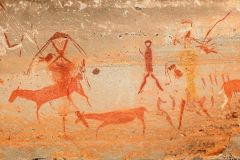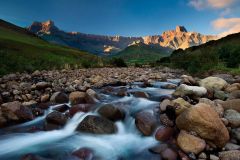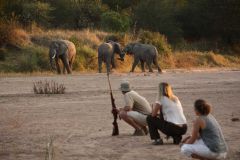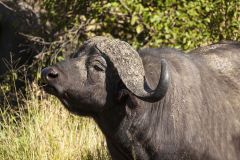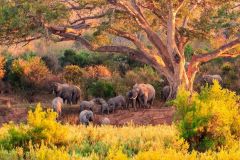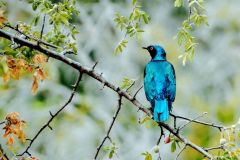Your stay at Balule River Lodge
Day to Day Programme
Balule River Lodge also offer packages, where you have a fixed programme more or less every day. Our safari programme offers morning and afternoon game drives as well as bush walks in our own area.
Hereby an example of a 7 days stay.
You will land in Johannesburg and after a wait of a couple of hours you will then fly to a local airport, either Phalaborwa or Hoedspruit, close to Kruger National Park. Here one of Balule’s guides will be waiting to meet you and drive you to the camp. You will be welcomed in camp with a tasty lunch. After an information meeting, you will be free to relax in your new surroundings.
On Saturday you will enjoy two game drives in open safari vehicles, a morning game drive starting at 6.00 am and an afternoon game drive at 15.30.
Hopefully we will be lucky enough to see zebras, wildebeest, elephant, giraffe, lion, warthog, impala, kudu, monkeys, rhinoceros etc., but as is always the case when it comes to wild animals, you can never be sure what you might see. But you can be certain of one thing: a safari like this is a wonderful experience, because you will be actively following the animals, their tracks and even their smell.
During the afternoon game drive, we will make a stop out in the bush just before the sun sets.
Here you will enjoy a classic “sundowner” while you enjoy the wonderful sounds and smells of the bush and its plant and animal life, before driving back to camp where your dinner will be waiting.
Before dawn you will be served a light breakfast in camp, then after an hour’s drive you will reach the state owned part of the Kruger National Park - just as the sun is rising.
The park is the biggest and most impressive animal reserve in South Africa, with a total area of around 20,000 square kilometers. In Kruger National Park you can really experience Africa’s wildlife “up close”, including “The Big Five” - the traditional name for the most sought after hunting trophies: Leopard, lion, rhinoceros, buffalo and elephant.
We will drive in an open safari vehicle, during your “hunt” for animals your guide will lead the way, and he knows exactly what you can expect to see. He knows the water holes, where the animals most often come and drink from, and which area of the plains the various species of animals usually can be found.
Underway we will stop at one of the park’s rest camps, where you will be served brunch prepared by your rangers. During the trip we will also stop in various places so you can stretch your legs, and also to eat lunch.
We will leave the park just before sundown and arrive back at Balule River camp, where a good dinner will be waiting for us.
Enjoy a relaxing day in Balule River Camp, relaxing by the pool or sitting on the terrace watching the animals that live near the camp.
You can also join one of the many extra tours that are available, you can for example, book a balloon safari, an Olifants River Cruise or a visit to Shangaan Tribal Village.
On Tuesday we again start with an early morning game drive in the camp’s open safari vehicle. We will look for animals in Balule Nature Reserve, as the bush wakes up, and the sun slowly climbs higher and higher in the sky. In the afternoon there will be another game drive in Balule Nature Reserve, where you will have a really good chance of seeing antelopes, giraffes, rhinoceros, monkeys and many other animals.
On the way we will stop to enjoy the sunset and enjoy a classic “sundowner” while you enjoy the wonderful sounds and smells of the bush and its plant and animal life, before driving back to camp where your dinner will be waiting.
Today it will be possible to book one of the extra activities on offer, e.g. an extra safari or horseback riding in the neighbouring area.
In the afternoon there will be another game drive in Balule Nature Reserve.
If the weather is good the evening will end with a traditional South African barbecue, a “bush braii”, at the scenic viewpoint of Lion View. Here we will enjoy a delicious dinner under the starry African night sky.
A wonderful atmosphere develops, as you smell the meat cooking on the grill, red wine is poured into your glass, the waiters lay the table with candles and a white tablecloth, when cicadas are singing and you can hear the roar of lions in the distance.
We start the day early with a game drive where you once again get to discover the amazing wildlife.
The afternoon will be at your own disposal. You can book one of the extra activities or just relax by the pool at the lodge.
In the morning you will be transferred from Balule River Camp to the local airport, from where you will fly to Johannesburg.
Activities & Attractions
Kruger National Park is the largest in South Africa and nearly 20,000 km2 in size. On top of this comes the large private reserves on the western side of the park. Kruger is also one of the oldest national parts in the world, with a history of more than 100 years to look back on. This means the animals have long lived peacefully here and are not shy. Like all parks and reserves in South Africa the Kruger is fenced, but the fences have been taken down along a stretch of circa 100 km where it shares a border with the majority of the private reserves, which together with a few private concessions in Kruger itself provide safaris of the very highest standard.
The vegetation here predominantly consists of savannah woodland, which is most lush to the south and driest in the north, where the huge, ancient baobab trees have their most southernly outpost on the continent. In amongst the areas of forest and bush you can find open areas of grassland with a number of rivers and waterholes. Kruger is home to the largest populations of animals in South Africa, and here you can also find more species of mammals and birds than in any other park. The classic “Big Five”, elephant, rhinoceros, buffalo, lion and leopard, are all common in Kruger. The park is particularly important for rhinoceros, in fact the most important on the continent, as here you can find more white rhino than in the rest of Africa, and nearly half of South Africa’s black rhinoceroses live here. Kruger also has fine populations of giraffe, zebra, wildebeests as well as many antelope species such as the greater kudu, eland, roan and sable antelopes, and here you can find more than 100,000 impalas. Baboons and meerkats are also very numerous, while the rivers are home to many crocodile and hippopotamus. The African wild dog is relatively common, and here you can also see cheetah.
Kruger is home to a rich and varied avifauna with many interesting birds such as storks, ostriches, secretary birds, numerous birds of prey and hornbills. The dry winter months from May to October are the best time to see big game. At this time the vegetation is at its least dense, and the animals are concentrated around the scarce water sources. The wetter summer months can show the park at its most lush, and is the best time for seeing birds and animal young.
The range of activities available west of the park and its associated private reserves is almost endless. Here you can, to give a few examples, find fantastic golf courses, fly in a balloon, and visit the magnificent Blyde River Canyon nearby. In the park and reserves themselves, the focus is naturally on highly professional guided safaris in open vehicles, both during the day, and in the dark using large flood-lamps. A number of places also offer the opportunity of taking part on a walking safari.
HIGHLIGHTS:
• Many unafraid animals in South Africa’s absolut biggest and most varied park
• The famous ”Big Five”, elephant, rhinoceros, buffalo, lion and leopard are often seen
• An almost overwhelming range of top quality camps offering highly professionel guiding
High Season: May to October
Balule Nature Reserve is home to the "The Big Five" and is world renown for its varied animal and bird life. Balule Nature Reserve is part of the Greater Kruger National Park, which is the name of the combined area of the state owned section of the park (the Kruger National Park) together with its neighbouring private reserves (which include Balule Nature Reserve), between which the fences have been removed to again allow the animals to move freely along their natural migratory pathways. The Olifants River is at the heart of the nature reserve, flowing for around 20 kilometers through the district.
Kruger National Park is South Africa’s biggest and most famous national park. It is 19.633 km2 in size (about the size of Jutland in Denmark) and was established in 1926 by Paul Kruger, who was the leader of the Transvaal Republic. The goal was, and still is, to protect the African wildlife here, and the park has fully lived up to this goal: here it is possible to see up to 147 different species of mammals, 104 different reptiles, 507 bird species and 1,771 plant species, which includes 357species of trees and bushes.
As one of the biggest game reserves in the world the Kruger National Park is without equal when it comes to animal life. Importantly the infrastructure providing an extensive network of roads, and the camps where it is possible to spend the night, have minimal impact on the original nature of the park. Nearly all the traditional African big game species can be seen here in South Africa’s nature reserves and parks, of which the Kruger National Park has the widest range. More than half of the 718 bird species found in South Africa can be seen in Kruger National Park, which makes it one of the most interesting destinations for birdwatchers in the world.
The closest towns are Phalaborwa and Hoedspruit, which are both around an hours drive from Balule River Lodge. Here you will also find the two airports, guests can fly to from Johannesburg.
Although to some it may sound like it will take you out of your comfort zone, a walking safari with an experienced guide is a completely different experience than a game-drive in a safari vehicle. In general you can get close to many of the interesting small species on foot, while a game drive is better for seeing the larger animals. Nearly all animals have an instinctive fear of humans, and while they are used to seeing people in safari vehicles which experience has taught them to regard as safe, they are still nervous about how dangerous people on foot can be.
The guides on walking safaris are usually locals who live in the surrounding area. They therefore have a thorough knowledge of how to use the vegetation that goes far beyond the level of “using wood as a building material and reeds for thatching”. Many plants species are used as natural medicines and have pain-killing or digestive effects. Some bushes with tough fibres can make excellent tooth brushes. Other plants can be used as an effective insect repellent, just flicking a small leafy branch of one of these plants over your shoulder and around your scalp, will keep away flies and mosquitos for a considerable period.
The guides can tell you exciting tales about some of the very small animals that live here that are just as important part of the local nature as the larger animals. Many places offer walking safaris that focus on local plantlife or, for example, the “Little Five”, or animals tracks and droppings. The latter are important themes for the relatively few places that have specialised in tracking some of the larger animals. Fresh signs and tracks are important signposts for finding a pride of lions or a rhinoceros
In some places, together with a very experienced guide, you can actually track lions and rhinos, and get close to other large animals such as elephants, buffalo, hippos, giraffes and hyenas. Leopards and cheetahs are rarely seen on foot, as they are very shy of people, and you can be sure that if they catch sight of anybody on foot, they will disappear in a flash. The guides are very familiar with the behaviour patterns of the different animals, and can read their moods, knowing when it is possible to approach closely, and when you should keep away from them. Often a walking safari will be joined by an armed guard, especially in areas where there are many large and potentially dangerous animals. It is very rare that they will need to fire their weapon, and in just about all the times this occurs, shooting a round or two into the air will be enough to avoid a dangerous confrontation.
In some national parks you can go on multi-day walks, accompanied by a team of helpers carrying tents and supplies, for example in the Luangwa Valley in Zambia and in Selous in Tanzania.
The Big Five is a historic term that comes from big game hunting. It groups together the five animals that were considered to require the most courage and skill to hunt: Elephant, rhino, buffalo, lion and leopard. The term has been readily adopted by today’s wildlife safaris, on which rifles have been swapped for a camera and animals are only “shot” through a telephoto lens. It is also widely used in the marketing of reserves, camps and lodges, where the “Big Five” can be found, and visitors have a reasonable chance of encountering them.
The Elephant
The African Elephant is the largest terrestrial mammal alive today, weighing up to 6.5 tons. It can easily be distinguished from the smaller Indian elephant by its larger ears and saddle shaped back. Elephant herds are led by an older female, known as the matriarch, and consist of related females, immature and young animals. Male animals live apart from the females, and only seek out the females when they are in, what is known as, musth - which is the elephants equivalent of the rut. Once they have left the family herd, young male animals often form small groups themselves.
The Rhino
The smallest of the two African species of rhino, the black rhino, is considered a member of the Big Five, while the larger white rhino is not. Despite their names, both species are grey in colour, although both often take on the colour of the mud- or dust they bathe in. Therefore it can be considered more correct to call the black rhino the hook-lipped rhino (its mouth is adapted to nibble leaves) and the white rhino the square-lipped rhino (it grazes on grass)! It is thought the misunderstanding about colour comes from a mistaking in translation from Dutch/Afrikaans or English, where the word wide can sound a lot like white.
The Buffalo
The Cape buffalo is very much a herd animal. During its migrations it can been seen in herds of up to one thousand individuals of mixed ages and sex, but more typically the herds are much smaller and contain no or very few bulls, which are more often seen in small, scattered herds of their own. Buffalo are never found far from water. Although a buffalo would seem to be the perfect size to be preyed on by lions, it can be very dangerous for lions to attack them as buffalo are very aggressive and have large, very sharp horns. Some prides of lions have specialised in hunting lions however.
The Lion
Lions live together in groups known as a pride which, if you don’t include male cheetah siblings which can stay together for most of their lives, is the only really gregarious species of cat. It is also the only species of cat that can have a tufted tail. While the female lion is the world biggest female cat, male lions, despite their large heads and impressive tails, are actually smaller than male Siberian tigers. In some districts the males have black manes, while in other districts you can find tree climbing lions, although they are not as accomplished at climbing as the leopard.
The Leopard
The beautiful leopard is the commonest and most widespread of the big cats, distributed from southern Africa to the Far East and Siberia. It is also extremely adaptable, and can be found in most types of habitat, including in a number of large cities. Despite this it is very difficult to catch a glimpse of, as it is very shy and rarely moves out in the open during daylight. There is also a black variant of leopard known as the panther, which is very rare in Africa. This cat is a member of the same species as the spotted variety, which is genetically dominant over the black variant.
This term arose as a light hearted response to the Big Five and includes five animals that include the big five names as part of their name. It was also intended by nature conservationists to remind visitors to look for and enjoy all the animals of the savannah, even the smallest while they are on safari.
Elephant Shrew:
Even though the elephant shrew resembles a giant shrew, one that can weigh up to 500 g. and are actually more closely related to elephants than the true shrews. It is also known as the jumping shrews and belongs to an Order of animals that includes nearly 20 different species. They all eat insects, typically ants, and have a very long tounge just like the anteaters. Elephant shrews are very shy, some of them clear a series of pathways through the undergrowth, which they patrol regularly. They are one of the fastest small mammals in the world and have been recorded reaching a speed of 28 km/h.
Rhinoceros Beetle:
This large group of beetles, which includes one species that is found over most of Northern Europe, are amongst the biggest and heaviest beetles of them all. Even though they look very menacing, they are all harmless herbivores. The males use their horns in often lengthy wrestling matches, or perhaps more correctly, jousts, with rivals around good breeding sites to attract the favour of nearby females. Luckily these fights do not result is any harm to the combatants. They spend the majority of their life, which can be a number of years long, as larvae hidden away under the bark of decaying trees.
Buffalo Weaver:
Buffalo weaver are members of the large weaver bird family, typical of Africa, they are the most easily seen member of the little five. They weave “closed” nests in the branches of trees, which helps protect eggs and young birds against predators. There are three species of buffalo weavers, in East Africa the most commonly seen is the white-headed buffalo weaver, which weave individual nests in small colonies, while in southern Africa only the red-billed weaver can be found, which weaves huge communal nests with many breeding chambers. They are typically found in areas with many buffalo, hence their name.
Ant Lion:
The ant lion is an insect, and it is actually the larval stage of this animal that has given it its name. It is the larvae that mainly eats ants as well as other small ground dwelling insects. Antlions live underground at the bottom of crater shaped funnels that they excavate in the sand or dusty earth. Here they wait for their prey to walk into the trap and slowly make their way down the loose sides of the trap towards the bottom, where the ant lion lies hidden and ready to strike with its long jaws. The jaws are hollow which allows them to literally suck their victims dry. The adult stage of the insect resembles a dragonfly.
Leopard Tortoise:
This tortoise gets its name because of the beautiful patterns that resemble the spotted coat of the leopard. The patterns are most beautiful on young individuals, while older individuals become more grey/brown in colour. It is Africa’s most common tortoise, and grow up to 70 cm in length and with a weight of around 50 kg, the world’s fourth largest species – the largest can be found on the Seychelles and Galapagos islands. Leopard tortoises are herbivores that thrive in even the driest parts of the continent. They can reach up to 100 years of age.
REMEMBER to enjoy all the beautiful animals you see on safari, and don’t just stress yourself by only searching for the big five (or the little five for that matter), for example there are also many species of monkey, giraffe, hippo, zebra, cheetah and a wealth of beautiful antelopes, not to mention the rich and varied birdlife of Africa which includes many species of large and colourful birds, topped off by the world’s largest bird, the ostrich. Then what about the crocodiles and monitor lizards?
The Drakensbergs are a mountain range close to the South Africa’s west coast, that over an area of some 250,000 hectares. The highest point in the Drakensburg is Thabana Ntlenyana, a mountain peak that towers 3,482 meters up into the heavens. If you enjoy walking, climbing or birdwatching the Drakensbergs are an absolute must. The area is famous for its dramatic scenery and wild nature, the bird life here is particularly exciting with many endemic species. In the year 2000 this district was named a World Heritage Site, partially because of the remarkable rock art that can be found here, that bear witness to the San peoples way of life and religious beliefs.
The Northern Drakenbergs
The northern part of the Drakensburgs rise in Free State Province and continue down to the Royal Natal National Park. The Royal Natal National Park is of note because it is the source of the River Tugela and features the Tugela Falls, which are the second highest waterfalls in the world. The northern section of the mountains also make up the major part of the range as a whole.
The Southern Drakenbergs
The southern part of the Drakensberg stretches from the Transkei, down into the Sani Pass region. There are a number of ways you can reach the Drakensburg, and you can approach the mountains from both the northern and the southern sections. One of the reasons the region is so exciting is because the park is included in the Ramsar Convention’s wetland conservation program, which means this fantastic district can be enjoyed by adventurous travellers safari in its original and unspoilt state.
Extra Experiences
Leave Time 13H00
Embarque on the boat for three hours of a unique river safari as you encounter crocodile, hippo and elephants up the Oliphants River along the banks of the Klaserie Game Reserve that borders the Kruger National Park. This is the original & best sundowner cruise on the river.
The top deck caters excellently for photographers and birding enthusiasts with chairs and tables to sit at and lay out your equipment and books.
Enjoy a sundowner on the boat deck as the brillant African sun sets and reflects along the stillness of this magical river. A completely different game viewing experience that you do not want to miss!
Experience the Africa that most tourists never see, when we visit Lulekani, a township on the border of Kruger National Park, which is home to the Shangaan people.
Accompanied by a guide, the tour includes a visit to the witch doctor, who is still a powerful personality in the Shangaan culture. We will also vist the local kindergarden, and see a traditionally built African house built from mud and straw and meet the family who lives there, both very moving experiences that can leave a powerful impression. We will also experience the township’s great social contrasts see the houses of both the township’s rich and poor inhabitants.
The tour finishes in a boma, where we will have the chance to taste a number of different african specialities. This tour is a fantastic way of experiencing traditional African culture, which is slowly being taken replaced by a more modern way of life.
This tour can be arranged for a minimum of 3 participants.
Regardless of whether you are an experienced rider or have never sat on a horse before, a horseback ride through the bush is a different, exciting way of experiencing South Africa’s wildlife.
On horse back it is possible to approach really closely to wild animals because they see you as part of the horse rather than as a human. During a ride of around 1 1/2 hours in the bush it is possible to enjoy close encounters with zebras, giraffes and wildebeest, while your guide tells you about the districts trees, bushes and flowers.
Remember to wear long trousers, closed shoes and a hat.
This tour usually takes place during the morning. No children under 12 years of age are allowed on the tour unless they have previous riding experience.
This tour can be arranged for a minimum of 2 participants.
Every morning at sunrise,our balloons depart from launch sites in the Hoedspruit area. Come aboard for an experience of a lifetime.
Experience the magic of lighter-than-air flight near the foot of the Drakendsberg Escarpment. The terrain is a mixture of farmland, private nature reserves and wildlife estates. The mountains to the South and West provide shelter from the prevailing winds, thereby affording us good flying weather on most days. On very calm days, they sometimes offer flights over the Kapama Nature Reserve, South-East of Hoedspruit.
The pilots and crew will ensure a safe, enjoyable and informative adventure that will be one of the highlights of your visit to the Kruger to Canyons Biosphere.
We meet before sunrise and coffee is served while you watch your eight-storey high balloon being inflated and prepared for flight. After a safety briefing you should be airborne in time to witness the sunrise. The height above ground will vary between skimming the tree-tops to as high as 2 000 feet as the pilot changes altitude in search of favourable wind directions and speeds.
As the sun rises, the landscape, the vegetation and, if you're lucky, some wildlife will provide photo opportunities. Game spotting cannot be guaranteed but on most flights we see plains game like giraffe and wildebeest. The flight duration is about an hour and towards the end of the flight the pilot will select a suitable landing site. The landing is an exciting event because the basket meets the earth at whatever speed the surface wind is at the time. Light airs allow the softest of landings while fresh breezes necessitate a "positive" landing so that the basket can serve as an anchor to slow the envelope down. If not already at the landing site, the ground crew will soon arrive to deflate and pack the balloon while passengers enjoy fruit juice and sparkling wine.
What to wear and bring along:
Though winter dawns can be nippy, once you're up in the basket, it will be surprisingly warm.
Warm clothes will be useful during pre-flight. Cameras and binoculars can be brought along.
At Hans Merensky Hotel & Spa, you will experience golfing like no other place. With the world renowned Kruger National Park bordering this exquisite Championship golf course, visitor from the African Wild can very likely be expected.
Designed by Bob Grimsdell, Hans Merensky Golf Course provides a truly unique golfing experience with a range of challenging holes. Having hosted many high-profile professional and amateur tournaments, the course is of widely acknowledged quality. The course is lined with bushveld forming a beautiful backdrop to the holes, and gives the impression that the course is far older than its 30 years.
Share your experience with our resident Giraffe, Hippo, Crocodiles and many other permanent residents! The 18 hole Bob Grimsdell designed Par 72 Championship Golf course has been voted as the best walking course in the country. Tee off between 07:00 and 09:00 or 11:30 and 13:30. Visitors are welcome any day of the week.
Our Helicopter tours start from Hoedspruits landings strip. You can choose between two different types of tour:
HELICOPTER TOUR 1 - DURATION CIRCA. 20 MINS:
On this tour you will fly over different game reserves and fruit plantations. The passengers can decide themselves how much of the time is spent on each area. The helicopter has room for 2-3 passangers.
HELICOPTER TOUR 2 - DURATION CIRCA.. 50 MIN:
This tour takes you over the ”Drakensbjergs” and a number of game reserves. Flying over this wonderful landscape really is an experience you will remember for a lifetime. During the tour you will fly amongst the mountains, see waterfalls and a section of the worlds biggest forestry plantation. The helicopter has room for 2-3 passangers.
Thsukudu is a privately owned family Nature Reserve and host to the Big Five. Thsukudu is famous for their cheetahs. Several years ago a cheetah cub was brought to Thsukudu. Her mother was killed by a lion and the cub needed a home and a surrogate mother. They named her Savannah and it turned out that she loved to be in the restaurant area, walk between people and sit and sleep on the sofa.
Savannah gave birth to 4 cubs and these 4 cubs are now grown and still around in the camp. Some of them also walk through the restaurant. So have a look in the main lodge and in the garden to see if you can find them. You are allowed to take pictures. Savannah is unfortunately no longer with us, she died protecting her cubs against a lion attack. Besides these cheetahs, Tshukudu is home to the famous and rare king cheetah as well. They also provide a house for some other animals in desperate need of some tender loving care.
Wake up: 06:00
Breakfast: 06:30 – 07:30
Leave from Balule River Camp: 07:30
The game drive will start at 09:00 until 12:00. In Tshukudu they are allowed to go off the roads to get up close with the animals.
If you can’t get enough of the game drives here, it is possible to book an extra game drive in Balule Nature Reserve with one of Balule’s guides.
The tour lasts – just like the other game drives included in your itinerary – circa. 3 hours.
Balule Nature Reserve is home to the famous Big Five but and has a very rich and varied animal and bird fauna.
You start your day early with an exciting open vehicle game drive. During the course of the day you will make a pit stop at a peaceful, scenic picnic spot or a Rest Camp where you can get something to eat before setting off to explore more of the Kruger National Park.
Kruger National Park is well-known for its boundless opportunities to spot the famous African Big Five – Elephant, Leopard, Buffalo, Rhino and of course Lion. Day safaris are conducted in open 4 x 4 safari vehicles.
The day trip is an ideal tour as it provides for a good overall experience at a relaxed pace. You will experience South Africa’s natural beauty, capture boastful wildlife photographs and have amazing African wildlife encounters. With so much on offer, a full day Kruger Park safari is the best way to experience the park if you have limited time and want to learn more about the park from our knowledgeable guides Jonathan and Edward.
Enjoy a trip trough the bush at high speed. This ATV tour starts close to Balule River Lodge and takes you into Balule Nature Reserve. You ride in a line one after another, with one guide in front and another guide at the rear, along narrow paths and gravel tracks that run trough the reserve. This tour is different fro a game drive in the area as you will be driving faster and can reach further into the bush along smaller tracks. As an ATV is not silent, you should consider this tour a game safari, but there is still a good chance of seeing a range of different game animals.
This tour takes place in the afternoon- It lasts around. 2hours and requires a minimum of 3 participants.
Fiona will be your beauty therapist for the day and will provide you with the requested treatments. You can choose from:
- Massages
- Pedicures
- Manicures
Each treatment will last approximately an hour.
As the beauty therapist is not a resident a minimum of 4 bookings is required.
Leave time: 08H00
The magnificent Panorama Route is best known for its cultural heritage and its dramatic landscapes. Offering a vast array of exciting options for the visitor, the Panorama Route hosts some of the best adrenalin enhancing adventures as well as some more sedate pastimes.
One of the major highlights of the region is the Blyde River Canyon Reserve, home to spectacular wildlife and birdlife and some of the best views in South Africa. The Blyde River Canyon is the third largest canyon of its kind in the world. You can visit the Three rondavels, Burk Luck Potholes, The pinnacle, Gods Window and it’s rainforest.
 _________________
_________________
Other highlights include the exquisite waterfalls in Graskop and Sabie, the Echo Caves that speak of Africa’s powerful tribes such as Pedi, Mapulane and Swazi, trails left behind by the Voortrekkers in regions such as Lydenberg and Ohrigstad, ancient artistic footprints left by indigenous peoples of Africa and the Gold Rush territory, Pilgrim’s Rest, home to the early gold prospectors.
